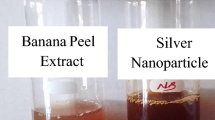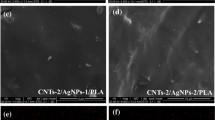Abstract
Colloidal silver nanoparticles with a size of 5.5 ± 1.1 nm were prepared by chemical reduction using polyethylene glycol (PEG). Silver nanoparticles were incorporated into low-density polyethylene (LDPE) by melt blending and subsequent hot pressing at 140 °C to produce nanocomposite film with an average thickness of 0.7 mm. PEG was added at 5% weight of polymer as a compatibilizer agent in order to prevent agglomeration and provide uniform distribution of nanoparticles in polymer matrix. Antimicrobial activity of silver nanocomposites against Escherichia coli ATCC 13706, Staphylococcus aureus ATCC12600, and Candida albicans ATCC10231 was evaluated by semi-qualitative agar diffusion test and quantitative dynamic shake flask test. Mechanical properties of nanocomposites were not significantly different from silver-free LDPE-containing PEG films (p > 0.05), and silver nanoparticles did not form chemical bonding with the polymer. LDPE-silver nanocomposite samples by more than 6.69 ppm silver nanoparticles showed considerable antimicrobial clear zone. LDPE-silver nanocomposite affected growth kinetic parameters of the examined bacteria and is more efficient on S. aureus than E. coli. Polyethylene-silver nanocomposites containing 22.64 ppm silver nanoparticles could reduce 57.8% growth rate and 23.3% maximum bacterial concentration and increase 35.8% lag time of S. aureus. This study shows the potential use of LDPE-silver nanocomposite as antimicrobial active film. Antimicrobial efficiency of silver nanocomposite depends on silver nanoparticles concentration; however, high level of silver nanoparticles may lead to weakening of mechanical properties.






Similar content being viewed by others
References
Appendini, P., & Hotchkiss, J. H. (2002). Review of antimicrobial food packaging. Innovative Food Science & Emerging Technologies, 3, 113–126.
Bouwmeester, H., Dekkers, S., Noordam, M. Y., Hagens, W. I., Bulder, A. S., Heer, C., et al. (2009). Review of health safety aspects of nanotechnologies in food production. Regulatory Toxicology and Pharmacology, 53(1), 52–62.
Cho, K. H., Park, J. E., Osaka, T., & Park, S. G. (2005). The study of antimicrobial activity and preservative effects of nanosilver ingredient. Electrochimica Acta, 51, 956–960.
Damm, C., Munstedt, H., & Rosch, A. (2008). The antimicrobial efficacy of polyamide 6/silver-nano- and microcomposites. Materials Chemistry and Physics, 108, 61–66.
Del Nobile, M. A., Conte, A., Buonocore, G. G., Incoronato, A. L., Massaro, A., & Panza, O. (2009). Active packaging by extrusion processing of recyclable and biodegradable polymers. Journal of Food Engineering, 93, 1–6. doi:10.1016/j.jfoodeng.2008.12.022.
Han, J. H. (2000). Antimicrobial food packaging. Food Technology, 54(3), 56–65.
Han, J. H., & Floros, J. D. (1997). Casting antimicrobial packaging films and measuring their physical properties and antimicrobial activity. Journal of Plastic Film and Sheeting, 13, 278–298.
Han, J., Castell-Perez, M. E., & Moreira, R. G. (2007). The influence of electron beam irradiation of antimicrobial-coated LDPE/polyamide films on antimicrobial activity and film properties. LWT, 40, 1545–1554.
Hong, S. I., Park, J. D., & Kim, D. M. (2000). Antimicrobial and physical properties of food packaging films incorporated with some natural compounds. Food Science Biotechnology, 9(1), 38–42.
Ishitani, T. (1995). Active packaging for food quality preservation in Japan. In P. Ackerman, M. Jägerstad, & T. Oglsson (Eds.), Food and food packaging materials—chemical interactions (pp. 177–188). Cambridge: The Royal Society of Chemistry.
Jokar, M., Abdul Rahman, R., Ibrahim, N. Z., Chuah Abdullah, L., & Chin Ping, T. (2009). Characterization and biocompatibility properties of silver nanoparticles produced using short chain polyethylene glycol. Journal of Nano Research, 9, 29–37.
Kim, J. S., Kuk, E., Nam Yu, K., Kim, J. H., Park, S. J., Lee, H. J., et al. (2007). Antimicrobial effects of silver nanoparticles. Nanomedicine, 3, 95–101.
Kwakye-Awuah, B., Williams, C., Kenward, M. A., & Redecka, I. (2008). Antimicrobial action and efficiency of silver-loaded. Journal of Applied Microbiology, 104(5), 1516–1524.
Lee, D. S., Hwang, Y. I., & Cho, S. H. (1998). Developing antimicrobial packaging film for curled lettuce and soybean sprouts. Food Science and Biotechnology, 7(2), 117–121.
Liau, S., Read, D., Pugh, W., Furr, J., & Russell, A. (1997). Interaction of silver nitrate with readily identifiable groups :relationship to the antibacterial action of silver ions. Letters in Applied Microbiology, 25, 279–283.
Marsh, K., & Bugusu, B. (2007). Food packaging—roles, materials, and environmental issue. Journal of food science, 72(3), 39–55.
Mauriello, G., De Luca, E., La Storia, A., Villani, F., & Ercolini, D. (2005). Antimicrobial activity of a nisin-activated plastic film for food packaging. Letters in Applied Microbiology, 41, 464–469.
Nobile, M. A. D., Cannarsi, M., Altieri, C., Sinigaglia, M., Favia, P., Iacoviello, G., et al. (2004). Effect of Ag-containing Nano-composite active packaging system on survival of Alicyclobacillus acidoterrestris. Journal of Food Science, 9(8), 379–383.
Pehlivan, H., Balkose, D., Ulku, S., & Tihminlioglu, F. (2005). Characterization of pure and silver exchanged natural zeolite filled polypropylene composite films. Composite Science and Technology, 65, 2049–2058.
Popa, M., Pradell, T., Crespo, D., & Calderon-Moreno, J. M. (2007). Stable silver colloidal dispersions using short chain polyethylene glycol. Colloids and Surfaces. A, Physicochemical and Engineering Aspects, 303, 184–190.
Quintavalla, S., & Vicini, L. (2002). Antimicrobial food packaging in meat industry. Meat Scienc, 62, 73–380.
Sondi, I., & Salopek-Sondi, B. (2004). Silver nanoparticles as antimicrobial agent: A case study on E. coli as a model for Gram-negative bacteria. Journal of Colloids and Interface Science, 275, 177–182.
Suppakul, P., Milts, J., Sonneveld, K., & Bigger, S. W. (2003). Active packaging technologies with an emphasis on antimicrobial packaging and its application. Journal of Food Science, 68, 408–420.
Suppakul, P., Sonneveld, K., Bigger, S. W., & Miltz, J. (2008). Efficacy of polyethylene-based antimicrobial films containing principal constituents of basil. LWT, 41, 779–788.
Swapna Joseph, C., Harish Prashanth, H. V., Rastogi, N. K., Indiramma, A. R., Yella Reddy, S., & Raghavarao, K. S. M. S. (2009) Optimum blend of chitosan and poly-(ε-caprolactone) for fabrication of films for food packaging applications. Food Bioprocess Technology. doi:10.1007/s11947-009-0203-1.
Vartianen, J., Skytta, E., Ahvenainen-Rantala, R., & Enqvisit, J. (2003). Antimicrobial and barrier properties of LDPE films containing Imazalil and EDTA. Journal of Plastic Film and Sheeting, 19, 249–261.
Vermeiren, L., Devlieghere, F., Beest, M. V., Kruijf, N. D., & Debever, J. (1999). Developments in the active packaging of foods. Trends in Food Science and Technology, 10, 77–86.
Wang, A. L., Yin, H. B., Ren, M., Cheng, X. N., Zhou, Q. F., & Zhang, X. F. (2006). Effects of different functional group-containig organics on morphology-controled synthesis of silver nanoparticles at room temperature. Acta Metallurgica Sinica, 19(5), 362–370.
Xie, M., & Li, H. (2008). Mechanical properties of an ultrahigh-molecular-weight polyethylene/polypropylene blend containing poly(ethylene glycol) additives. Journal of Applied Polymer Science, 108(5), 3148–3153.
Zielinska, A., Skwarek, E., Zaleska, A., Gazda, M., & Hupka, J. (2009). Preparation of silver nanoparticles with controlled particle size. Procedia Chemistry, 1, 1560–1566.
Zwietering, M., Jongenberger, I., Roumbouts, F. M., & Riet, K. V. (1990). Modeling of bacterial growth curve. Applied and Enviromental Microbiology, 56(6), 1875–1881.
Author information
Authors and Affiliations
Corresponding author
Rights and permissions
About this article
Cite this article
Jokar, M., Abdul Rahman, R., Ibrahim, N.A. et al. Melt Production and Antimicrobial Efficiency of Low-Density Polyethylene (LDPE)-Silver Nanocomposite Film. Food Bioprocess Technol 5, 719–728 (2012). https://doi.org/10.1007/s11947-010-0329-1
Received:
Accepted:
Published:
Issue Date:
DOI: https://doi.org/10.1007/s11947-010-0329-1




